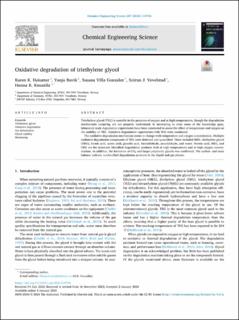| dc.contributor.author | Høisæter, Karen Karolina | |
| dc.contributor.author | Buvik, Vanja | |
| dc.contributor.author | Gonzalez, Susana Villa | |
| dc.contributor.author | Vevelstad, Solrun Johanne | |
| dc.contributor.author | Knuutila, Hanna Katariina | |
| dc.date.accessioned | 2024-01-31T14:36:03Z | |
| dc.date.available | 2024-01-31T14:36:03Z | |
| dc.date.created | 2024-01-25T09:19:37Z | |
| dc.date.issued | 2024 | |
| dc.identifier.citation | Chemical Engineering Science (CES). 2024, 287 . | en_US |
| dc.identifier.issn | 0009-2509 | |
| dc.identifier.uri | https://hdl.handle.net/11250/3114903 | |
| dc.description.abstract | Triethylene glycol (TEG) is unstable in the presence of oxygen and at high temperatures, though the degradation mechanisms occurring are not properly understood. In attempting to close some of the knowledge gaps, laboratory-scale degradation experiments have been conducted to assess the effect of temperature and oxygen on the stability of TEG. Oxidative degradation experiments with TEG were conducted.
The oxidative degradation mechanism seems to change with temperature and oxygen concentration. Multiple oxidative degradation compounds of TEG were detected and quantified. These included MEG, diethylene glycol (DEG), formic acid, acetic acid, glycolic acid, formaldehyde, acetaldehyde, and water. Formic acid, MEG, and DEG are the dominant identified degradation products both at high temperatures and at high oxygen concentrations. In addition, the formation of CO2 and larger polymeric glycols was confirmed. The carbon- and mass balance indicate unidentified degradation products in the liquid and gas phases. | en_US |
| dc.language.iso | eng | en_US |
| dc.publisher | Elsevier | en_US |
| dc.relation.uri | https://doi.org/10.1016/j.ces.2024.119706 | |
| dc.rights | Navngivelse 4.0 Internasjonal | * |
| dc.rights.uri | http://creativecommons.org/licenses/by/4.0/deed.no | * |
| dc.title | Oxidative degradation of triethylene glycol | en_US |
| dc.title.alternative | Oxidative degradation of triethylene glycol | en_US |
| dc.type | Peer reviewed | en_US |
| dc.type | Journal article | en_US |
| dc.description.version | publishedVersion | en_US |
| dc.source.pagenumber | 14 | en_US |
| dc.source.volume | 287 | en_US |
| dc.source.journal | Chemical Engineering Science (CES) | en_US |
| dc.identifier.doi | https://doi.org/10.1016/j.ces.2024.119706 | |
| dc.identifier.cristin | 2234177 | |
| dc.relation.project | Norges forskningsråd: 320257 | en_US |
| dc.relation.project | EC/H2020/294766 | en_US |
| cristin.ispublished | true | |
| cristin.fulltext | original | |
| cristin.qualitycode | 2 | |

